Selected projects

Mesoscale Modeling of Degradation and Erosion
Understanding and controlling the degradation of polymer networks plays a vital role in a variety of applications. Degradable hydrogels find their use in controlled drugs delivery, wound dressings design, as cell culture platforms, and as photolithographic materials. We are developing Dissipative Particle Dynamics framework that captures erosion, reverse gelation, and elasticity of controllably degrading polymer networks. In addition, we are also developing mesoscale approach to model chain scission during controlled degradation of thermoplastics to optimize recycling and reuse.
Vaibhav Palkar, Devanshu Thakar, Olga Kuksenok " Nanogel Degradation at Soft Interfaces and in Bulk: Tracking Shape Changes and Interfacial Spreading", Macromolecules 56 (4),1289-1302, (2023)
Data and python Jupyter notebooks for the manuscript Nanogel Degradation at Soft Interfaces and in Bulk: Tracking Shape Changes and Interfacial Spreading" are available on Zenodo: zenodo.org/record/7410537#.ZB9H6OzMJz9
V. Palkar, O. Kuksenok "Controlling Degradation and Erosion of Polymer Networks: Insights from Mesoscale Modeling", J. Phys. Chem. B 126, 1, 336–346 (2022)
Palkar, V., Choudhury, C. K., Kuksenok, O. "Development of Dissipative Particle Dynamics framework for modeling hydrogels with degradable bonds”. MRS Advances (2020)

Modeling Hydrogels with Host-guest Interactions
We model the dynamics of photo-responsive hydrogels with pendant azobenzene moieties immersed in the α-cyclodextrin (α-CD) solution. While trans-azobenzene moieties are accommodated by the α-CD cavities forming inclusion complexes resulting in hydrogel swelling, exposure to UV irradiation induces trans-to-cis photoisomerization leading to decomplexation and matrix deswelling. We demonstrate swelling-induced patterns in confined samples upon adding the α-CD solution in the dark and show that spatiotemporal variations in UV irradiation effectively control patterns formed and hysteresis loops.
Yao Xiong, Olga Kuksenok " Photocontrol of pattern formation and hysteresis loops in polymer gels with host-guest interactions", iScience 25 (12),105606, (2022)Data and analysis notebooks are available on Zenodo: zenodo.org/record/7306921#.ZB9FsezMJz8
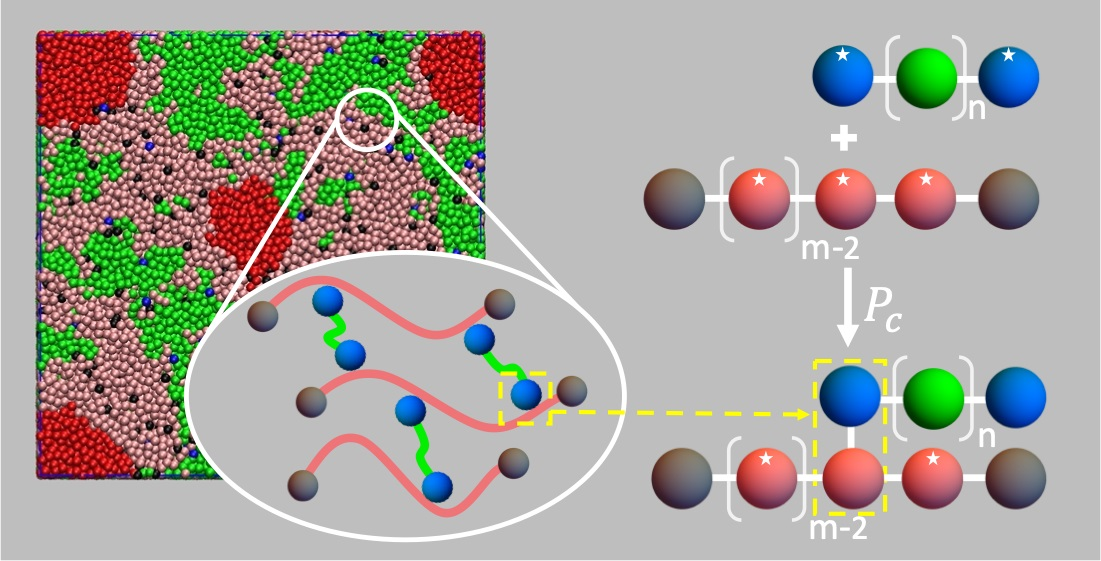
Modeling Phase Separation Controlled by Hydrosilylation reaction
Controlling morphology of polysiloxane blends crosslinked by the hydrosilylation reaction followed by pyrolysis constitutes a robust strategy to fabricate polymer-derived ceramics (PDCs) for a number of applications, from water purification to hydrogen storage. We introduce a dissipative particle dynamics approach that captures the phase separation in binary and ternary polymer blends undergoing hydrosilylation. Linear polyhydromethylsiloxane (PHMS) chains are chosen as preceramic precursors and linear vinyl-terminated polydimethylsiloxane (v-PDMS) chains constitute the reactive sacrificial component. Hydrosilylation of carbon–carbon unsaturated double bonds results in the formation of carbon–silicon bonds and is widely utilized in the synthesis of organosilicons. Our results demonstrate that the morphology of the sacrificial domains polymer network formed can be tailored by tunning the composition, chemical nature, and the degree of polymerization of the sacrificial component.
Collaborators: Prof. Rajendra K Bordia (CU)
"Mesoscale Modeling of Phase Separation Controlled by Hydrosilylation in Polyhydromethylsiloxane (PHMS)-Containing Blends", Nanomaterials 12 (18), 3117 (2022)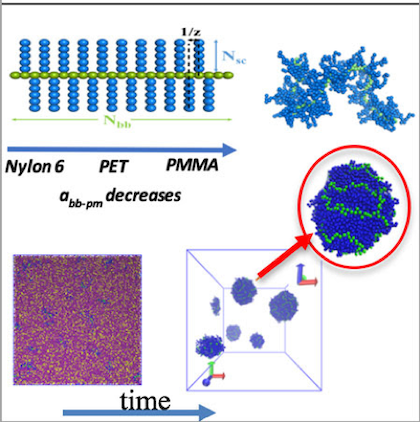
Modeling Molecular Bottlebrushes
Molecular bottlebrushes are macromolecules with side chains anchored to the backbone at high grafting densities. An ability to control the bottlebrush architecture in a relatively straightforward manner during its synthesis makes them an attractive candidate for various applications. We focus on bottlebrushes with PFPE (Perfluoropolyether) sidechains, same as in the concurrent experimental studies in Luzinov’s group. An advantage of these bottlebrush additives is that they are non-toxic and environmentally friendly. Experiments in Luzinov’s group showed that addition of a small fraction of bottlebrushes with PFPE sidechains to various polymer matrixes dramatically increases oil repellency of the films.
Collaborators: Prof. Igor Luzinov (CU)
S. Tu, C.K. Choudhury, M. Giltner, I. Luzinov, O. Kuksenok "Mesoscale Modeling of Agglomeration of Molecular Bottlebrushes: Focus on Conformations and Clustering Criteria", Polymers 14 (12), 2339 (2022)Wei, L, Caliskan, T.D., Tu, S., Choudhury, C.K, Kuksenok, O, Luzinov, I. "Highly Oil-Repellent Thermoplastic Boundaries via Surface Delivery of CF3 Groups by Molecular Bottlebrush Additives", ACS Applied Materials & Interfaces (2020) 12 (34), 38626-38637
Tu, S., Choudhury, C. K., Luzinov, I., Kuksenok., O. "Recent advances towards applications of molecular bottlebrushes and their Conjugates”. Current Opinion in Solid State and Materials Science , 23 (1), 50-61 (2019)
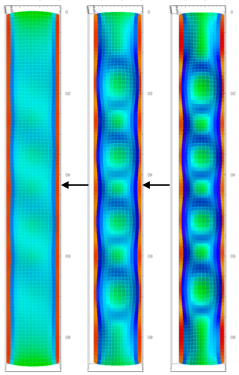
Dynamic Control of Pattern Formation in Responsive Networks
Pattern formation plays a critical role in nature, from spontaneous organization in flocks and crowds to organs development during morphogenesis. Controlling pattern formation in synthetic materials could allow one to control a wide range of functionalities. Using continuum modeling (gel Lattice Spring Model ), we focus on dynamic control of pattern formation in confined responsive hydrogels.
Xiong, Y. et al "Phase Transitions and Pattern Formation in Chemo‐Responsive Gels and Composites" Israel Journal of Chemistry (2018).
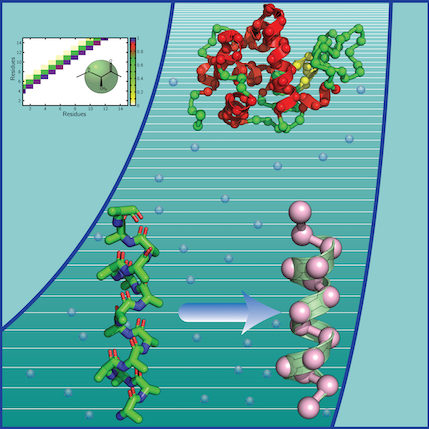
Mesoscale Modeling of Biomaterials
We developed a native-based Dissipative Particle Dynamics (DPD) framework that captures polyalanine folding into a stable helical conformation. We now focus on further development of computationally efficient native-based DPD approaches for modeling proteins and biomaterials incorporating α-helical segments.
Designing Highly Thermostable Enzyme-Copolymer Conjugates
Collaborators: Prof. S. Minko (UGA), Prof. I. Luzinov (CU)
Choudhury, C.K., Tu, S., Luzinov, I., Minko, S., Kuksenok, O., "Designing Highly Thermostable Lysozyme-Copolymer Conjugates: Focus on Effect of Polymer Concentration" Biomacromolecules 19 (4), 1175-1188 (2018)
Yadavalli N.S., Borodinov, N., Choudhury, C.K., Quiñones-Ruiz, T., Laradji, A.M., Tu, S., Lednev, I.K., Kuksenok, O., Luzinov, I., and S. Minko. "Thermal Stabilization of Enzymes with Molecular Brushes" ACS Catalysis 7 (12), 8675-8684
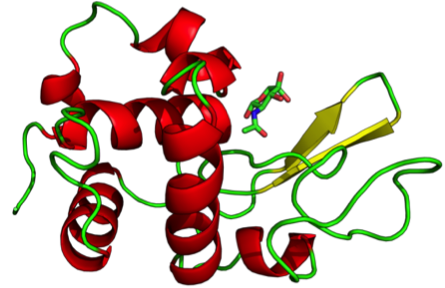


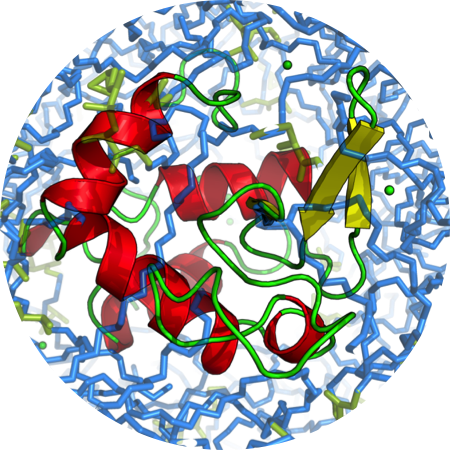
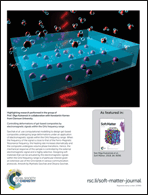
Gels Filled with Ferromagnetic Nanoparticles
Focus on selective response on GHz frequencies
Collaborators: Prof. K. Kornev (CU)
Savchak, O., Morrison, T., Kornev, K.G. and Kuksenok, O. Controlling deformations of gel-based composites by electromagnetic signals within the GHz frequency range. Soft matter, 14(43), pp.8698-8708 (2018)
Last updated: Mar 24, 2023
